

 |
 |
I clicked 'refresh' for what seemed like the one hundredth time on my lap top as I studied the animated satellite images for some sign of hope. Tonight was the peak of the Perseid meteor shower and to say I was excited was an understatement, for not only were the Perseids one of the best major annual showers but this year conditions looked to be quite exceptional with the peak occurring in conjunction with a dark moonless sky, I could sense that this one was going to be good and knew I would be making an extra special effort this night to see it so I spent my daytime hours relentlessly studying every piece of weather data I could find to work out if we were going to get a clear sky or not. The forecast was not good, the days and nights leading up to maximum were overcast however there was room for some hope for the August 12th/13th peak, at first the weather was not encouraging, the television weather favoured Britain as the main place to be however things were not so clear cut for Ireland. Models predicted a clearance which might move into E and SE areas of the country after sunset with counties Down, Armagh and east Antrim looking to be the best, I was considering hitting Down and perhaps meeting up with the Irish Astronomical Association (IAA) who were doing their own public watch at Delamont Country Park, this would be an option however it would also be a very long drive from Maghera, I was still up for it however if there was a chance of clear skies slightly closer to home then that would make the drive back during the morning all the more appealing.
Several hours later and after studying the most recent satellite images I was fairly confident that SW parts of N. Ireland could get clear gaps, especially over Tyrone and Fermanagh, however there were no promises here and confidence was 50/50, there was always the chance I could drive there and be under 100% cloud, or worse, arrive under clear gaps which then vanish for the rest of the night when you are far from home, I was still trying to work out my move and at this point I was wondering if I would even see one Perseid the entire night. By evening Paul Martin got in contact with me as he too was up for a full-on Perseid watch and was also debating the best location to go to, he was also tempted with Down and Armagh as a last resort however like myself he was getting lured into the possibilities to the SW. I had a long look at everything, frontal cloud over the E was slowly moving away to the E across the Irish Sea while to the W another massive cloud band was over the Atlantic threatening western areas, smack bang in the middle was a lot of moisture, charts indicated a SEly onshore breeze which would likely clear up any cloud in those areas and to the W an on-shore SWly was pushing cloud inland, however as we watched a miracle happened which took everyone by surprise, a massive clearance to the SW began moving N across Ireland very rapidly and was pushing much further N than anticipated and it looked like southern areas of N. Ireland were going to be completely clear before sunset and would stay that way for hours, even better was the SW area for that clearance was heading in that direction too and the frontal cloud to the W over the sea was actually dissolving, furthermore a new front was moving into S. Ireland later would not get us this far N until morning so we were highly confident that we were going to see the Perseids, we chose Co. Fermanagh and would play it by ear once we got there.
I left Maghera late in the evening and headed SW to Omagh where clear skies could be seen on the horizon complimented by sunset altocumulus clouds in the process of breaking, things were looking excellent indeed. I met Paul in town then we relocated to his partner Tracy's house where we had a last cup of tea and a look at the satellite imagery then all three of us hit the road. Darkness fell swiftly and even in the bright dusk sky Paul was sure he saw bright meteors low in the sky, we continued into Fermanagh and the sky was getting dark enough for our watch to begin so we decided we would just take the next road we saw and try our luck from there, within minutes we saw an option to the right and soon we were on a road none of us had been on before, we hoped the road would lead us to a nice location and once we cleared the trees were were not disappointed, in truth, we were celebrating for we had found a truly gorgeous location. We wasted no time and got out into the developing darkness and soon we had counted 3 Perseids, the radiant was climbing higher by the minute and the sky was 100% clear, the location was simply stunning and because it was new to us this added greatly to the buzz we all felt, it was as if we were on some astronomical holiday. We walked across the long jetty and absorbed the atmosphere, got dark adapted, and found our bearings. The sky was remarkable and after 10 min's of blending into the area we couldn't wait any longer so we rushed back to the jeep and got our camera gear ready then retraced our steps back to our viewing spot where we could spend the rest of the night.
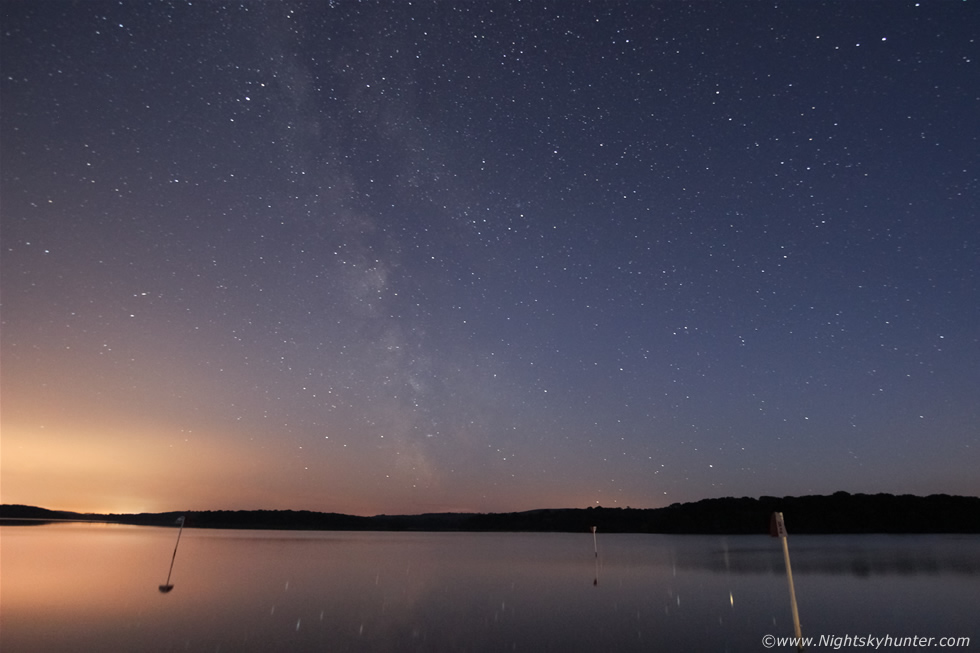 |
So here I was with Canon 600D and 10mm Samyang F/2.8 lens set-up at the very end corner of this lovely wooden jetty standing above deep water and looking across Lower Lough Erne. The great lake was absolutely calm and serene, aloft the sky was 100% clear with not a cloud in sight, this was significantly more than we had expected, we simply couldn't believe our luck. The twilight glow was merging into darkness and the sky had that atmospheric dark blue look which required an exposure for the memory. This was facing W/SW with the glorious Milky Way (MW for short) and stars reflecting upon the surface of the lake, what a beautiful view. The light pollution glow on the left was from distant Enniskillen and although it looks strong in this long exposure it did nothing to hamper the naked eye view, in fact, we were getting a naked eye limiting magnitude between +6.0 and +6.2 across the zenith which is highly respectable indeed. After a Summer of twilight the view of this dark sky and MW was jaw dropping and as full darkness fell across the lake the MW seemed to glow like a luminous cloud with great structure on view, this image shows the scene faithfully with the MW streaming down from overhead into Aquila then branching off into two main streamers within Scutum then peaking in brilliance lower on the horizon within Sagittarius where the heart of our own barred spiral galaxy is located. This entire area is rich in star clusters, emission and reflection nebulae, planetary nebulae, absorption nebulae and even the dark nebulae made famous by Astronomer Bart Bok which brought these dark areas to fame, you can see the dark structure on here between the MW banding, that's not a gap in the MW it is nebulae and dust clouds blocking star light and even absorbing it, truly fascinating stuff, admiring all this with the naked eye brought back vividly all those Summer nights spent comet hunting with my 16" reflector years ago, over the course of hundreds of hours of sweeping I was able to recognize everything in that MW through my scope, it was such a joy to experience these deep sky treasures first hand.
Nostalgia continued as I stood watching the sky working out where I was going to do my photographic meteor patrol, I knew from experience that it's best to simply watch and see where the greater number of meteors were falling, that would be the first patrol area, then as the radiant climbed higher and trekked further W the window area would shift further N, it has always been my opinion during major meteor showers that the region of sky to the NW, N and NE is most productive, this area is a favorite of mine because it gives the meteor a chance to enter the atmosphere and travel across the constellations then ablate a substantial distance from the parent radiant, this tends to happen in the very areas I mentioned where meteors tend to be longer with a greater chance of fireballs, these areas always begin at the horizon and extend half way to the zenith. My first target area with the 10mm lens would be the sky sector to the W and NW with the MW in the frame and with foreground including a portion of the lake, I have always been a big believer in having the horizon/foreground in the frame because it provides the viewer with a sense of scale and presence despite the obvious issues with atmospheric extinction low in the sky.
I have been observing meteor showers now for 18-19 years, I have observed major showers, minor showers and even did long watches for sporadics on nights when no major activity was expected, these were often long hours on my own or with a mate and much of this time was before any digital cameras appeared in my life so back then everything was 100% visual observation and because of this it was incredible fun to do, however it was not easy and often I found myself so busy recording everything on paper that I barely had time to savour the moment. I used a tape recorder and every time I observed a meteor I would press record and talking out loud I would mention the time, whether it was a shower member or not, magnitude estimate, colour description and direction, constellation and if a fireball was observed a description was given on fragmenting, glowing ion trains, smoke trails and any extremely rare audio phenomena heard. Then I would pocket the tape recorder, take out my red torch then on a clip board I had a circle of white paper taped on with all the major constellations sketched beforehand, then on this I would draw a line with a pencil in that constellation corresponding with the length of the meteor with the time in UT. Imagine doing this with every single meteor for an entire night with freezing hands, it made for the development of great visual skills and record keeping however you can see how much it can get in the way of a relaxing night. Now all of that has changed, I no longer feel I need to do that and I feel absolutely free, happy and liberated to just watch the sky with the naked eye and simply count how many I see, this was true pleasure and the way a meteor shower should be viewed.
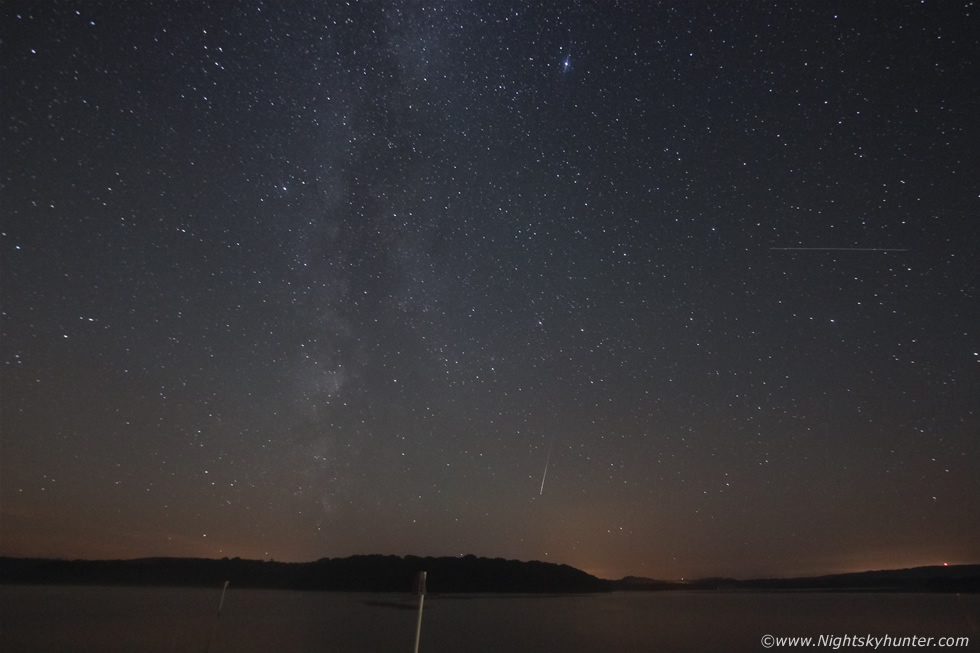 |
Perseid activity was strong and we knew we were in for a good night, I had my camera clicking away on continuous shooting mode, to my left Paul was shooting out W with his Canon 6D and behind me Tracy was laying on the jetty on a blanket watching the sky carefully, she would catch the meteors which were missed and together we kept a count out loud so there was no confusion. We had already reached 100 before midnight which was impressive and we wondered just how many we would get before the night was done. Here's one I caught during my patrol to the W-NW, this was a bright Perseid shooting down through the region of sky between the 'Tea Pot' of Sagittarius and Ophiuchus 'The Serpent Holder', the scene looked nice with the MW in the frame. Capturing a good meteor is not easy, remember that even bright meteors as seen with the naked eye may only show up as a short faint line on camera, or even not at all, the reason is because the meteor is moving at incredible speed across the sky, in the case of the Perseid meteoroids which originate from comet Swift-Tuttle - a long period comet on a retrograde orbit - meaning that the meteoroids from this comet will be meeting the Earth head-on with an encounter velocity of 60km/sec, in real time watching the meteor may only be visible for 1-2 seconds at swift speed which makes them very difficult to register on camera, you need a dark site, fast lens, good sensor and high ISO to improve your chances of success. The one on the above image may not look exceptional however with the naked eye it was as bright as Vega and hence of 0 magnitude.
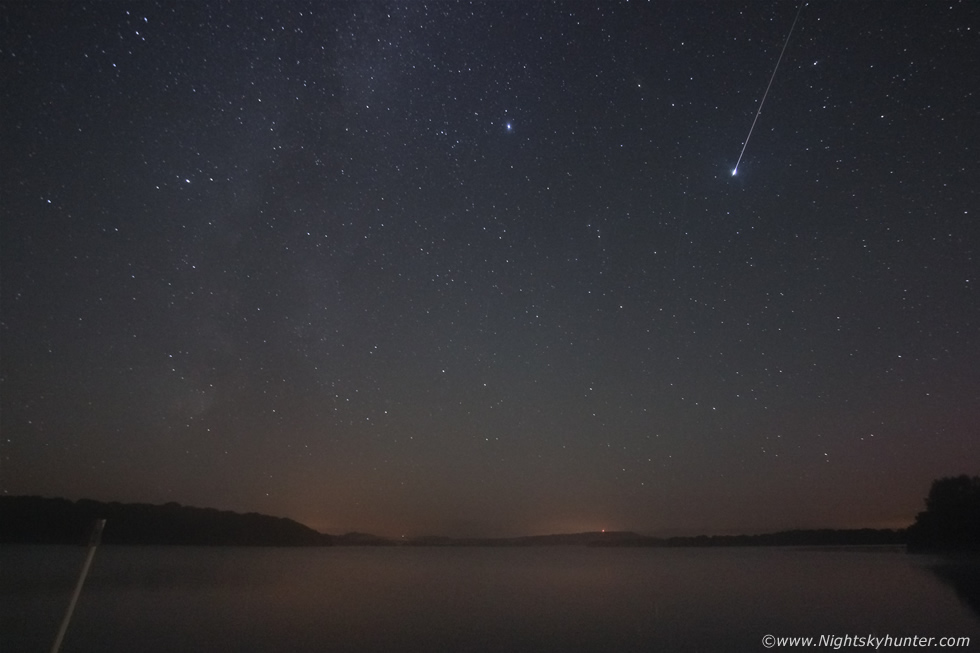 |
During the early morning hours a surreal blanket of mist covered the entire lake which really added to the atmosphere, however with it came major issues with dew and soon got to the point that I could no longer take images on continuous shooting which ruled out doing any star trails or time lapse photography. Now it was a full-on manual photographic patrol, I turned my camera to the NW-N sky sector to accommodate the westward drift of the radiant behind me and began a new patrol with the cable release in hand. I had to watch my sky sector carefully while shooting then wipe the dew off my lens every two minutes, Paul had now changed position to my right and was shooting the same area too, we were getting cold standing in the same position for hours but we persevered and it paid off. Suddenly Perseid 297 appeared from the radiant and shot into the N through both our frames, Paul and I both yelled 'WOW!!!'' for this was a fireball. We were talking moments earlier about how great the activity was however none of us had yet seen a true fireball from the Perseids yet, then suddenly this happened. The fireball crossed the sky lasting several seconds with a long tail then ablated into a blazing diamond head which flared/flashed with green colour leaving a straight glowing ion train in its wake, it was an absolute beauty and what made it more satisfying was that we had each captured it on camera, this was our prize catch of the night. The image is at 10mm, the fireball was nicely framed entering the sky from the upper right through Draco with Vega and the MW complimenting the scene, nature even placed it nicely in the rule of thirds too.
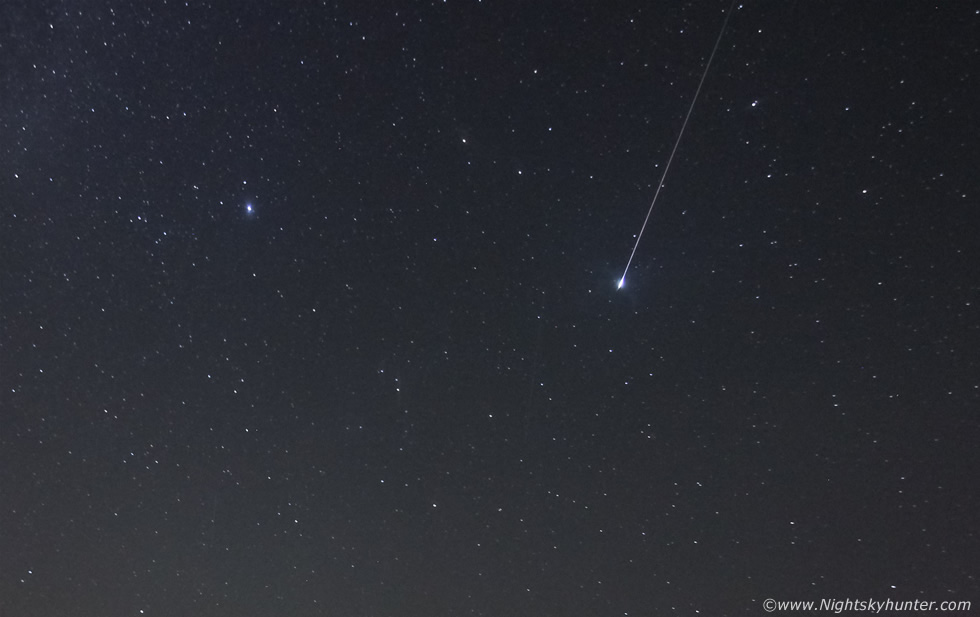 |
Crop showing the fireball and bright star Vega, the silver-blue head of the Perseid is also illuminating the mist in the sky where ablation took place. A fireball is any meteor brighter than planet Venus which shines at magnitude -5.0, that's bright because Venus is so bright it can be seen with the naked eye in day time when at a favourable elongation from the sun. In Astronomy negative magnitudes are brighter than positive magnitudes, eg: mag +6 is the typical naked eye limit on a moonless night, mag -5 is Venus, mag -10 to mag -12 is a full moon and mag -27 is the sun. I estimate the fireball to be in the mag -7 to -8 range, each one increment in magnitude is a difference of 2.5 times so a mag -8 fireball is extremely bright indeed, it's a definite shadow caster and a feather in the cap to witness.
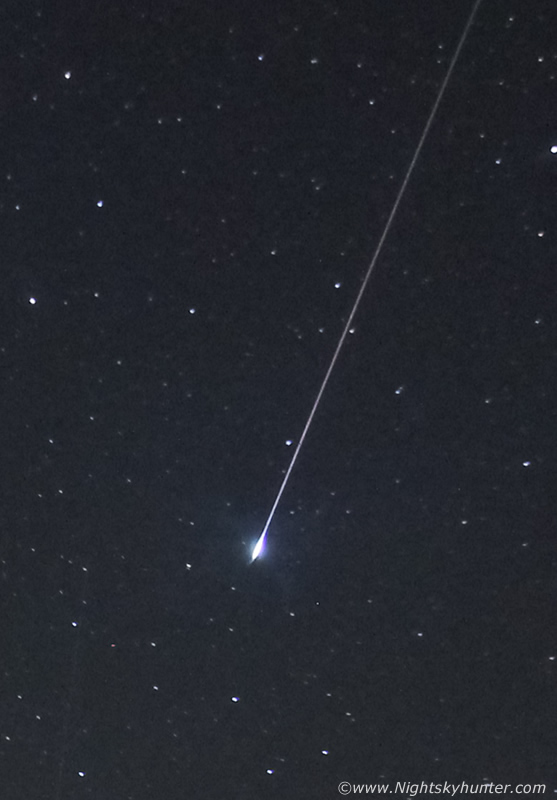 |
A very deep crop of the same fireball, we were delighted with this catch and decided that anything else this night would simply be the icing on the cake so we kept patrolling and observing.
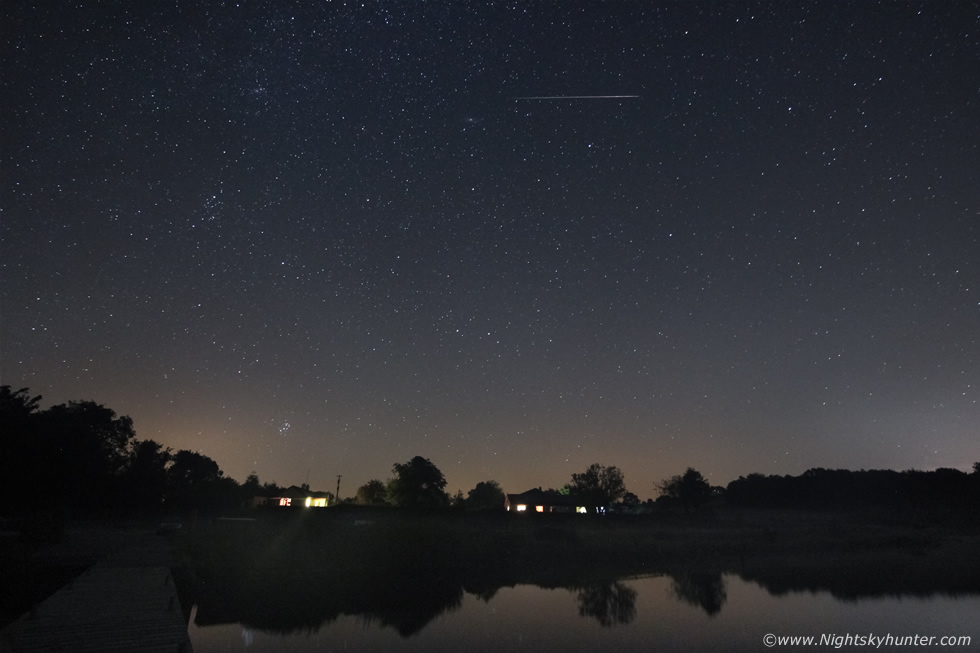 |
I panned the camera around and did a manual patrol facing E, I caught another Perseid shooting straight out from the radiant through Andromeda into Pegasus. If you look carefully you can see the jetty in the darkness to the left upon which we stood. There where two cars in the distance, the occupants of one were also watching the meteor shower because I could hear them reacting to what they saw in the sky, once they left the other car remained and was quiet, it had steamy windows so we figured they were looking down instead of up!
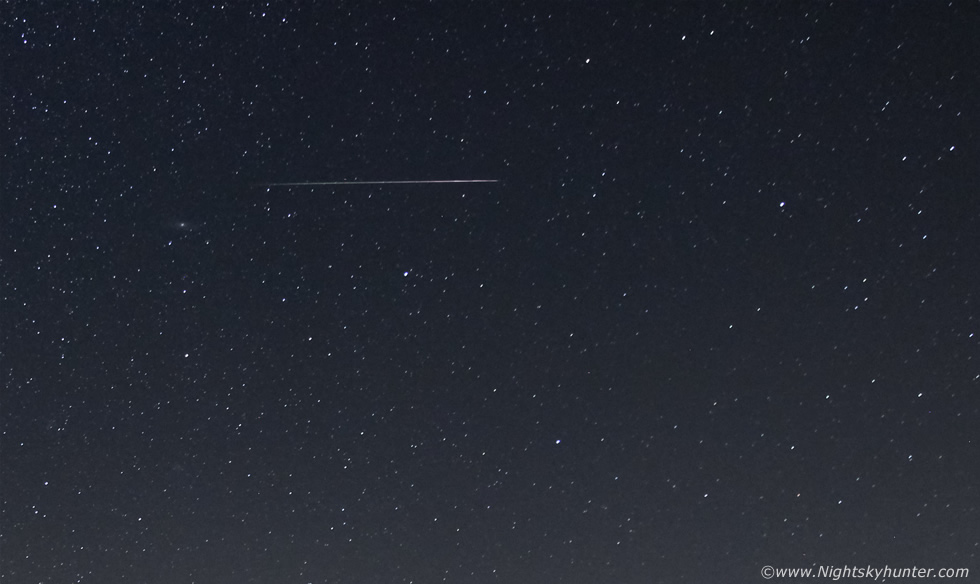 |
Crop of the same Perseid with the Andromeda Galaxy (M31) visible as a smudge to the left, the Pinwheel Galaxy (M33) in Triangulum is also visible as a smudge further to the S.
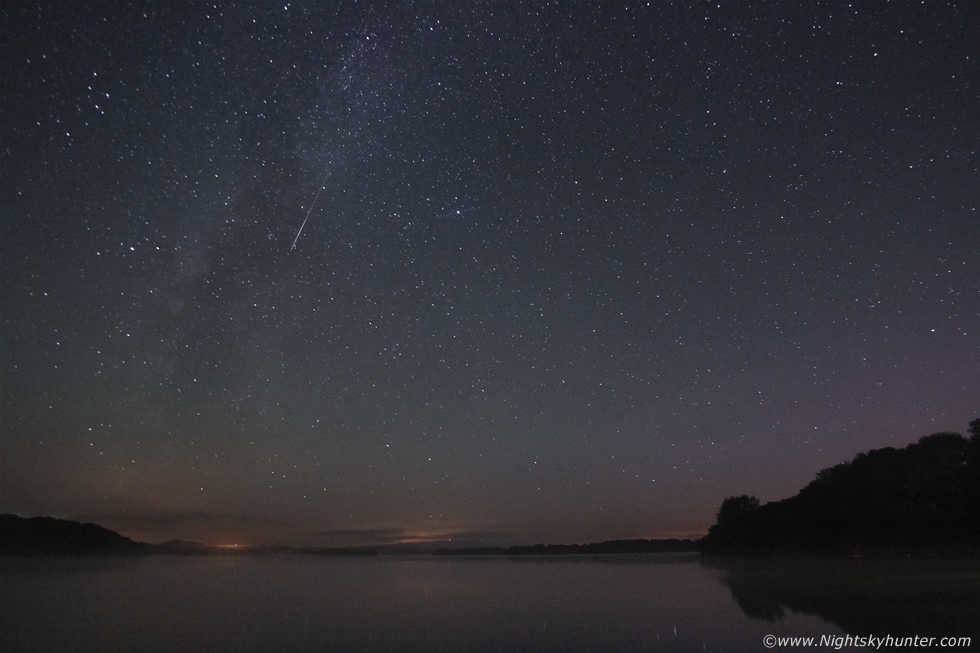 |
Late in the night with a count of over 300 and still seeing Perseids, I've now turned back to my NW-N sector. Here's another I captured in the MW with the head near the Coathanger Asterism (Collinder 399).
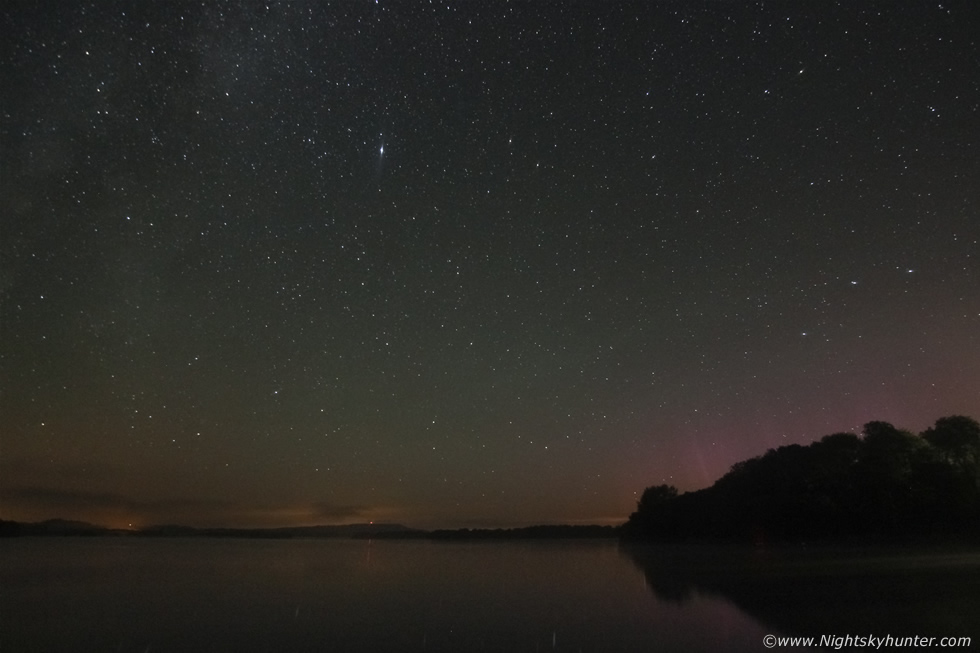 |
During the early hours of the morning I noticed a strange pink glow appear on the lower right of my LCD screen on all my latest patrol images, not thinking of anything other than meteors I began to suspect it was an artifact from such continued use related to overheating, on my old 450D I used to get a purple glow at the edge of the screen caused by the same issue, I mentioned it to Paul who began to examine his own images and soon I heard, ''Martin that's an aurora!'', with his full frame camera he was able to confirm it and sure enough with the naked eye we could see a colourless enhancement and a few min's later we witnessed a brief flurry of naked eye beams beyond the trees in front of us then it was gone. Here's one of the images showing that faint aurora complete with angled rays, that was a nice surprise which we hadn't expected, I don't think any of us had seen an aurora during the Perseid meteor shower before.
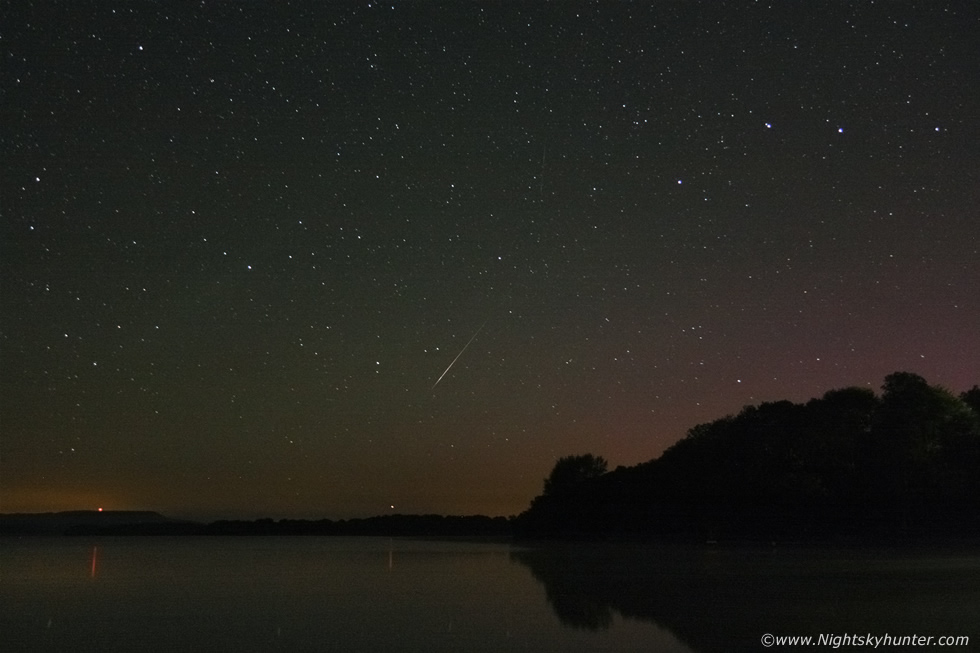 |
Before dawn I had three cameras set up, my 600D at 10mm, beside it my old 450D on continuous shooting at 18mm, both pointed in the same general area but with greatly different focal lengths and field of view. The 18mm would take in a much smaller section of sky but if a bright Perseid entered the frame then it could look good. The 450 did catch this mag +1.0 Perseid in Bootes 'The Herdsman' complete with red auroral glow behind the trees. Later I set up my Go Pro Hero 4 making for three cameras patrolling simultaneously, even though it was unlikely the Go Pro would catch meteors I set it up on Night Lapse mode anyway just to capture the night for the memories, it was doing continuous wide angle 30 second exposures at ISO 800.
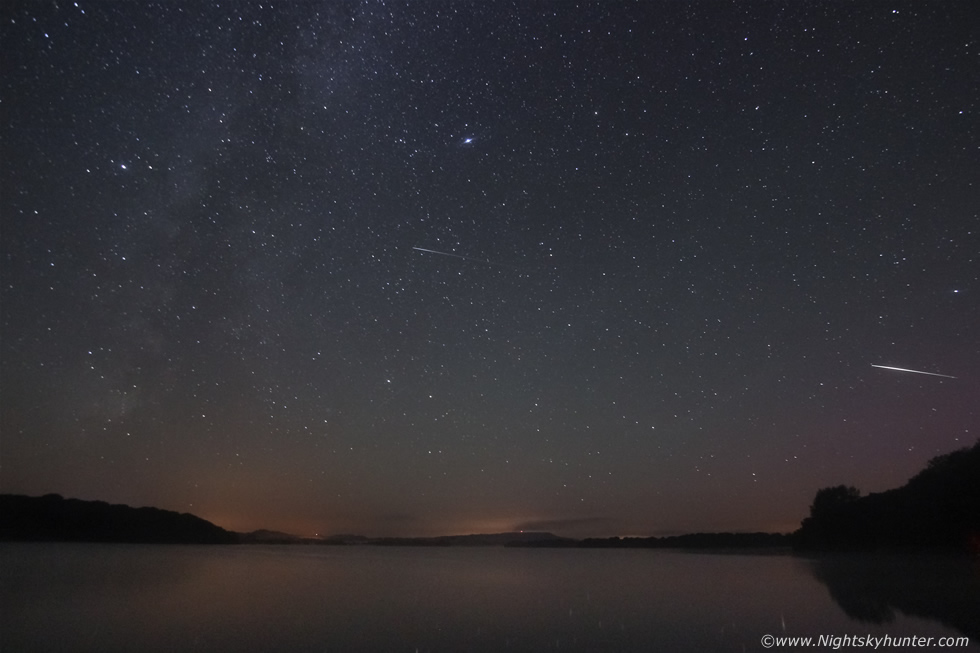 |
There's no shortage of phenomena to watch in the night sky, this is something the old time astronomers would never see in the form of man made craft drifting across the sky visible as moving stars. Here are two bright satellites in chase across the sky captured with the 10mm lens, the one to the far right is an Iridium flare. At the other side of the lake to the N we could see fireworks exploding in the sky, we speculated it was a party or wedding at the Country Manor Hotel further around the lake. While all this was going on I also had my video camera running on the jetty beside us recording audio, the idea was to capture the memory and listen to our real time reactions to the Perseids we saw including our count in an attempt to capture what it was like to be here with us in the moment. We had to be very careful on this jetty in the dark, either side of us was deep water so we had to make slow delibrate movments so we didn't slip or trip over a tripod leg and fall into the lake, or worse, knock the cameras in.
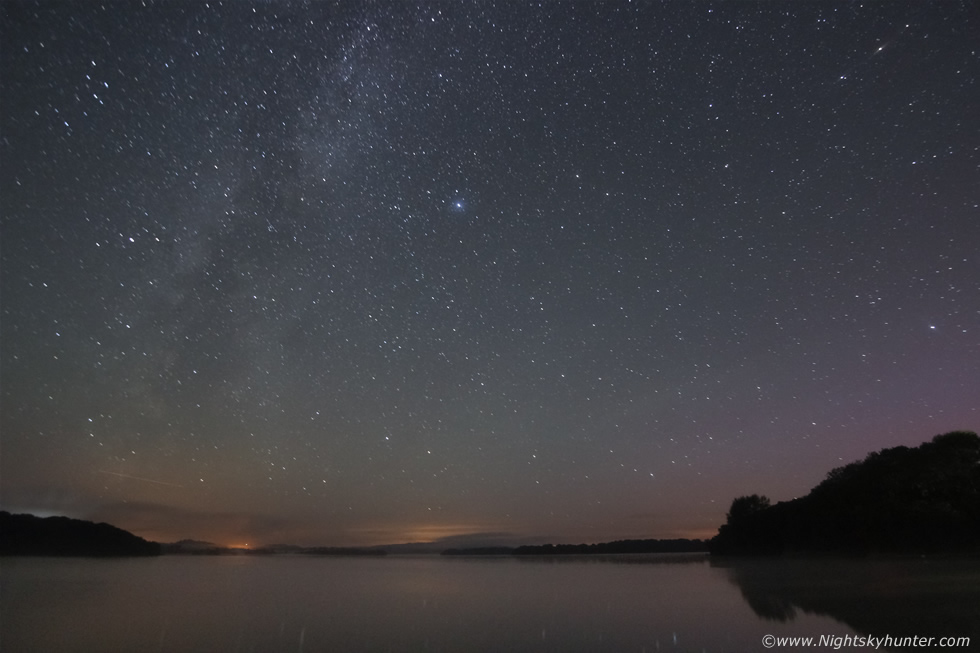 |
Just before dawn and close to the end of our watch, here's a final exposure of the sublime view we had from this calm lake with MW, green air glow with gravity waves and pink aurora complimented by an ocean of stars. The atmosphere was silent except for the call of distant Geese and the surface of the lake gently breaking from a feeding Trout, the stars flickered on the water then the mist engulfed the entire lake in spectacular fashion just as morning twilight began to wash the stars from the sky. Our final count came to an astonishing 477 meteors including two fireballs. We couldn't cover all the sky together and there were instances when our attention to the sky was briefly interrupted by camera duties so there was very likely more Perseids that went unseen. This was without question the best Perseid meteor shower we have ever seen and to think that this night started off with cloud and the possibility of seeing no meteors at all and to think that it would end with an entire clear night and with a count shy of 500 meteors was unbelievable, what a night to remember!. Paul drove us back to Omagh then I drove from Omagh to Maghera at dawn, I was extremely tired at this point driving through dense fog and if it wasn't for the red lights of a truck in front of me all along the Omagh road to concentrate on I very well could have strayed from the road, however I made it home for 06.00 UT then climbed into bed for a well deserved rest. Thanks very much for reading.
Martin McKenna